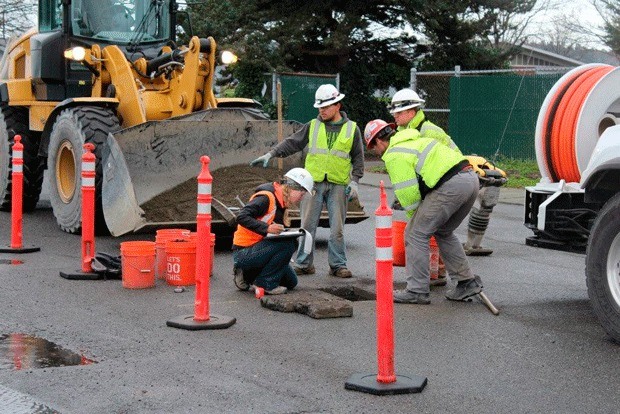Last month, an archaeologist discovered ancient human remains unearthed at the site of the Oak Harbor sewage treatment plant project.
The inadvertent discovery had little impact on the project as city officials developed detailed plans to handle such an event and coordinated with a long list of government agencies and Native American tribes before the digging even started, City Engineer Joe Stowell said.
“When we found something, everybody worked collaboratively and followed the work plans we have in place,” he said.
In 2011, discovery of a Native American burial ground created long delays in the project to convert Pioneer Way into a one-way road and ended up costing the city millions of dollars. City officials hadn’t followed recommendations from the Department of Archaeology and Historic Preservation to hire an archaeologist and plan for an inadvertent discovery.
This time around, the planning and the response — as well as the scale of the discovery — has been very different.
“I think we learned from what happened on Pioneer Way,” Stowell said, “and I think we applied it in spades on this project.”
Prior to the start of the sewage plant project, a memorandum of agreement was established that set out a work plan on how to handle inadvertent discoveries. It was signed by six tribes, the state Department of Ecology, the Environmental Protection Agency, the state Department of Archaeology and Historic Preservation and the city.
Equinox Research and Consulting International, a Mount Vernon firm hired by the city, monitors work at the site, which abuts Windjammer Park.
Before Christmas, the on-site archaeologist noticed the human remains in an area newly excavated.
On Jan. 14, the protocols were followed and remains recovered through a “focused excavation.”
The work was monitored by the Jamestown S’Klallam Tribe, Lummi Nation, Samish Indian Nation, Stillaguamish Tribe of Indians, Swinomish Indian Tribal Community, The Suquamish Tribe, Tulalip Tribes and Upper Skagit Indian Tribe. Representatives of the EPA, the Department of Ecology and city were also present.
Stowell said it took weeks to coordinate the excavation, but work on the treatment plant was able to continue in another area. The recovery was completed in a day.
Officials are tight-lipped about details of the discovery. Stowell said the city didn’t alert the public about it until this week because of the tribes’ sensitivity to the issue.
A press release was approved by all the tribes and government agencies involved before it was sent out.
Stowell said there are strict rules the city must adhere to regarding dissemination of information about ancient human remains; that includes federal law because some of the funding for the project originated with the federal government.
Stowell said the remains that were spotted were “very subtle.” He said cultural resources exposed to elements oxidize quickly.
The site of the new sewage treatment plant used to be the location of a slough and a spit. Much of the ground is material that was used to fill in the slough, Stowell said, but there’s an interface with the natural material that once made up the spit.
Kelly Bush, president of Equinox Research, said she also couldn’t discuss details of the find because of confidentiality stipulations in the memorandum of agreement and ensuing work plans.
She said that there is a higher likelihood in Western Washington of finding ancestral remains near the shoreline. The soil in upland areas tends to be highly acidic. Shell remains at the shore leach calcium carbonate, which reduced the acidity and slows decomposition.
That’s the reason that city officials wanted to push the treatment as far north as possible at the site, which is just south of the bay; it’s simply less likely that ancient remains will be found the farther away from the water workers get.
Bush’s team analyzed the site with a series of trenches before work started, which led to the reworking of the site map and plans to possibly raze the aging Whidbey Island Bank building on the north side of the project.
Other evidence of pre-contact activities were found at the site, including shell midden.
Bush said a reburial plan will be developed between the state, federal government and the tribes.
“The City of Oak Harbor recognizes our unique history on Whidbey Island and the need to protect the cultural resources of the community,” Mayor Bob Severns said.
“Recorded history dates back far before a formal city existed here, when American-Indian ancestors inhabited the same areas we use today for home and play.”
“This rich history and ancestry must be formally recognized on a project like the Clean Water Facility,” he said.



